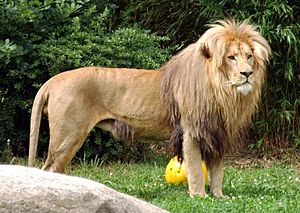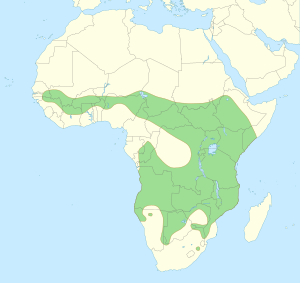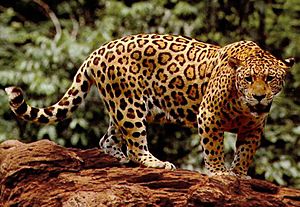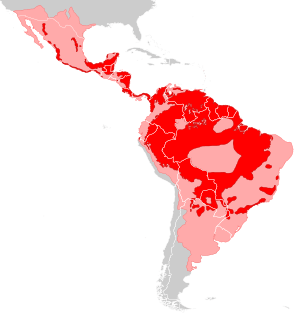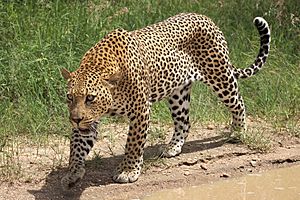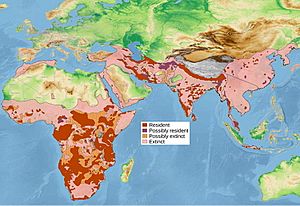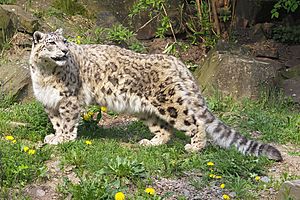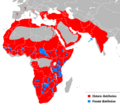Panthera facts for kids
Quick facts for kids Panthera |
|
|---|---|
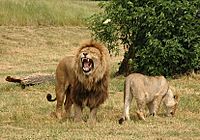 |
|
| Two lions (Panthera leo) | |
| Scientific classification | |
| Kingdom: | |
| Phylum: | |
| Class: | |
| Order: | |
| Family: | |
| Subfamily: | |
| Genus: |
Panthera
Oken, 1816
|
| Type species | |
| Felis pardus Linnaeus, 1758
|
|
Panthera is a genus of the family Felidae. It has five living species, which are the biggest cats in the Felidae. The tiger is the largest Panthera species, and the largest of all cats. The leopard is the smallest Panthera species.
Results of genetic analysis indicate that the snow leopard also belongs to the Panthera, a classification that was accepted by IUCN assessors in 2008. The genus Neofelis is also closely related.
The tiger, lion, leopard, and jaguar are the only cat species with the anatomical structure that enables them to roar. The primary reason for this was formerly assumed to be the incomplete ossification of the hyoid bone. However, new studies show the ability to roar is due to other morphological features, especially of the larynx. The snow leopard does not roar. Although its hyoid bone is incompletely ossified, it lacks the special morphology of the larynx.
Contents
Etymology
The word panther derives from classical Latin panthēra, itself from the ancient Greek pánthēr (πάνθηρ). The phonetically similar Sanskrit word पाण्डर pând-ara means 'pale yellow, whitish, white'.
Characteristics
In Panthera species, the dorsal profile of the skull is flattish or evenly convex. The frontal interorbital area is not noticeably elevated, and the area behind the elevation is less steeply sloped. The basicranial axis is nearly horizontal. The inner chamber of the bullae is large, the outer small. The partition between them is close to the external auditory meatus. The convexly rounded chin is sloping. All Panthera species have an incompletely ossified hyoid bone. Specially adapted larynx with proportionally larger vocal folds are covered in a large fibro-elastic pad. These characteristics enable all Panthera species except snow leopard to roar. Panthera species can prusten, which is a short, soft, snorting sound; it is used during contact between friendly individuals. The roar is an especially loud call with a distinctive pattern that depends on the species.
Classification
During the 19th and 20th centuries, various explorers and staff of natural history museums suggested numerous subspecies, or at times called races, for all Panthera species. The taxonomist Pocock reviewed skins and skulls in the zoological collection of the Natural History Museum, London and grouped subspecies described, thus shortening the lists considerably. Since the mid-1980s, several Panthera species became subject of genetic research, mostly using blood samples of captive individuals. Study results indicate that many of the lion and leopard subspecies are questionable because of insufficient genetic distinction between them. Subsequently, it was proposed to group all African leopard populations to P. p. pardus and retain eight subspecific names for Asian leopard populations.
Based on genetic research, it was suggested to group all living sub-Saharan lion populations into P. l. leo. Results of phylogeographic studies indicate that the Western and Central African lion populations are more closely related to those in India and form a different clade than lion populations in Southern and East Africa; southeastern Ethiopia is an admixture region between North African and East African lion populations.
Black panthers do not form a distinct species, but are melanistic specimens of the genus, most often encountered in the leopard and jaguar.
Phylogeny
The cladogram below follows Mazák, Christiansen and Kitchener (2011).
| Pantherinae |
|
||||||||||||||||||||||||||||||||||||||||||||||||||||||
In 2018, results of a phylogenetic study on living and fossil cats were published. This study was based on the morphological diversity of the mandibles of saber-toothed cats, their speciation and extinction rates. The generated cladogram indicates a different relation of the Panthera species, as shown below:
| Panthera |
|
|||||||||||||||||||||||||||||||||||||||||||||||||||||||||||||||||||||
Contemporary species
The following list of the genus Panthera is based on the taxonomic assessment in Mammal Species of the World and reflects the taxonomy revised in 2017 by the Cat Classification Task Force of the Cat Specialist Group:
| Species | Subspecies | IUCN Red List status and distribution |
|---|---|---|
| Tiger P. tigris (Linnaeus, 1758) | Tigers of mainland Asia P. t. tigris (Linnaeus, 1758) including:
Sunda Island tiger P. t. sondaica Temminck, 1844) including
|
[[Endangered species|]] |
| Lion P. leo (Linnaeus, 1758) | P. l. leo (Linnaeus, 1758) including:
P. l. melanochaita (Smith, 1842) including:
|
[[Vulnerable species|]] |
| Jaguar P. onca (Linnaeus, 1758) | Monotypic | [[Near Threatened|]] |
| Leopard P. pardus (Linnaeus, 1758) | African leopard P. p. pardus (Linnaeus, 1758) Indian leopard P. p. fusca (Meyer, 1794) |
|
| Snow leopard P. uncia (Schreber, 1775) | Monotypic |
Images for kids
See also
 In Spanish: Panthera para niños
In Spanish: Panthera para niños





